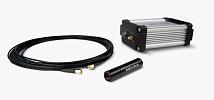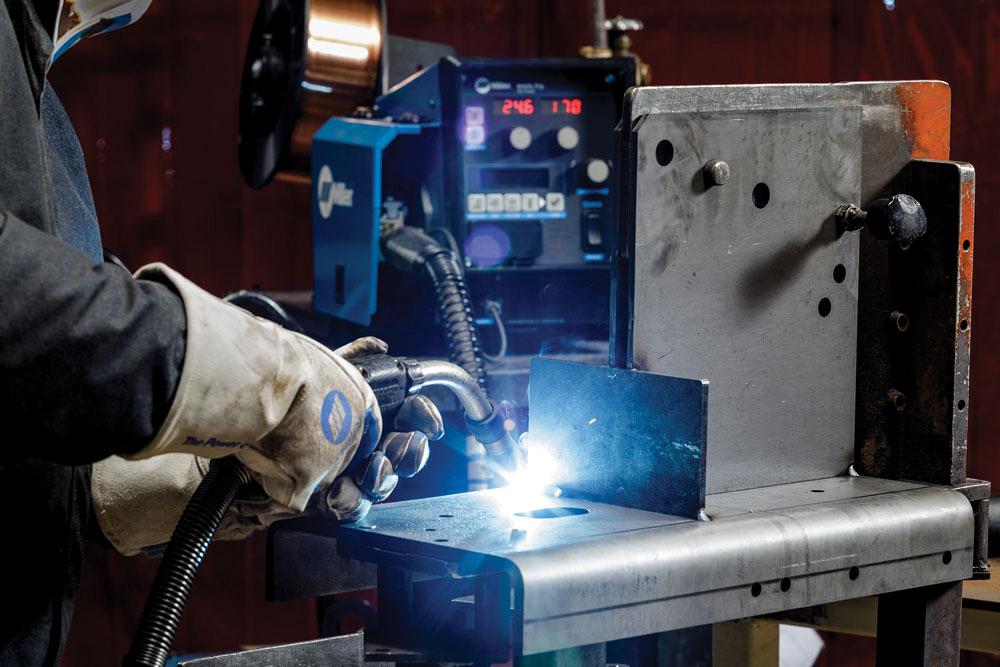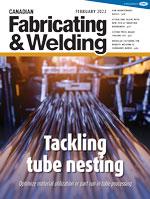Field Technical Support Specialist
- FMA
- The Fabricator
- FABTECH
- Canadian Metalworking
Welding gun maintenance basics
High throughput with a semi-automatic or robotic welding gun requires careful management of all its moving parts
- By Justin Craft and Roger Robey
- February 23, 2022
- Article
- Welding
A critical part of maintaining your shop’s semi-automatic and robotic welding guns is good preventive maintenance (PM) practices. Companies that have biannual shutdowns generally include PM checks on this equipment, but depending on your application, these checks may be required more regularly.
Following are a number of concerns that welding shops should watch for in their PM processes.
Liner Wear
A lot of factors play into liner wear; one of the biggest is the actual wire itself. Wire with an irregular cast in it can cause a liner to wear out prematurely.
In robotic applications, sometimes the operator will teach a weld with a 90-degree bend in the robot arm. Doing this, however, induces cast in the wire that can result in increased wear in the liner and the contact tips. In addition, such a severe bend can start damaging the cables.
Drive roll tension can add to cast problems. If your drive roll tension is too tight, you can add cast to the wire, creating more pressure on one side of the liner than the other. Creating a heavier cast in the wire puts a groove in the liner, wearing it out faster and increasing wire drag. This increased tension can also affect your contact tips, creating keyholing a lot faster than normal wear patterns. Make sure your drive roll tension isn’t set like a guitar string and that it has some give.
Drive roll tension should be checked regularly. It is easy to assume you can set the tension and forget it, but drive rolls, unchecked, will naturally drift as a result of heat and vibration.
Liner Trimming
Trimming your liner to the right length, whether for a semi-automatic or robotic application, is one of the most important things in any welding application. A mistrimmed liner is easily the No. 1 issue in gas metal arc welding (GMAW) applications, resulting in erratic arc and burnt-back contact tips. Short trimmed liners can cause burnbacks, premature tip failure, microarcing, and even birdnesting in the feeder.
People tend to want to trim liners short or flush to a gooseneck, but that isn’t always the proper method. Be sure to follow the manufacturer’s specifications on what method you are using because it can vary and may depend on the consumables you are using.
With some semi-automatic technologies, the liner is locked on both ends of the gun so that there is no guesswork in the trimming. If you aren’t using this type of setup, a precise trim is important.
Connections
Another PM practice that often gets overlooked is ensuring connections in your gun are properly tightened. Like with drive rolls, it’s easy to assume that connections are “set it and forget it,” but with heat cycling and vibration from use, all of the connections in a welding gun will loosen over time. Most notably, diffuser-to-neck or neck-to-cable connections – connections that typically don’t get replaced very often – are overlooked.

Managing nozzles and contact tips properly can have a great impact on the efficiency of your semi-automatic or robotic welding application. A big part of this is being able to tell when your consumables have reached their natural lifespan. Tregaskiss
Tight connections are an issue even with contact tips, though. Many people think that hand-tightening a contact tip is good enough because it feels tight to them. But it will work its way loose. A loose connection creates resistance, resistance is heat, and the more heat created, the less efficiently a gun will perform. Tips can melt to diffusers because they are too loose, and gun handles can melt because the connections on the cable in the handle are too loose. Checking these connections in a PM schedule and following torque specs are critical.
The connection to the cable is going to loosen up regardless of the brand or how it is made, but look for a product that has a mechanical connection rather than a crimped one that can’t be repaired. This can be a big cost savings in the long run. A tapered connection, compared to one that is simply threaded, can also add strength to a connection, as well as an improved surface for transferring current.
Cable Duty Cycles and Length
It’s important to understand the duty cycles of cables when you are buying them. If you experience cable failures, that can be related to duty cycle. For instance, some may think that when welding over 300 amps they have to use a water-cooled welding gun. However, some air-cooled guns go up to 350 amps for through-arm robotic applications and up to 385-amp duty cycle at 100 per cent with mixed gases for conventional over-the-arm cables. People see their cables failing at 285 amps and automatically think the cable is at fault. Understanding duty cycles can help you avoid any such misconception.
In robotic applications, cable length is a sensitive issue too. These cables are set for a very precise length, but some maintenance teams aren’t aware of this; they will run through cables every few months and not understand why. If the cable is mounted and locked at the feeder and at the gun, when the cable moves it doesn’t have much play. If a longer or shorter cable is incorrectly ordered and installed, it will always fail prematurely.
Each robot’s cables are set for a different length as well. Some might think they can swap out cables from one to another if they are within an inch or two. But as explained, cable life will be shortened by doing so.
Consumable Knowledge and Care
Managing nozzles and contact tips properly can have a great impact on the efficiency of your semi-automatic or robotic welding application. A big part of this is being able to tell when your consumables have reached their natural lifespan. Using a diffuser with damaged threads can obviously affect the quality of a weld and contact tip life. But equally, misdiagnosing a problem and simply switching out a diffuser because it is the simplest solution can waste both time and money. For instance, if a liner is cut too short, it can create problems that may appear to be related to the contact tip. However, careful inspection of the liner cut length should clear this up. It’s useful to review with newer welders what indicates wear or damage in a nozzle to ensure the correct solution to a problem is discovered.
Applying anti-spatter is one way to extend the life of nozzles. However, be sure that you apply the correct amount. If you put too much on such that fluid is dripping, this can result in poor-quality welds in the first arc after applying anti-spatter. Dipping the entire nozzle in anti-spatter fluid can eat away at the insulation material in the nozzle, which can cause a rapid failure. Some anti-spatter is applied as a paste; if improperly applied, this type can clog diffuser gas holes, which results in porosity and other quality issues in the weld.
Correct sizing of contact tips is also something that has to be properly thought through. Often welders think that contact tips should be “on par” with the wire being used: in other words, matching a 0.045-in. contact tip with a 0.045-in. wire. But this isn’t always the ideal.
The rule of thumb is to undersize your contact tip on barrels of wire that are 500 lbs. or more. This is due to the cast of the wire. With a 50-lb. spool of wire, you can use a contact tip that is on par because the cast is smaller. But again, it is best to check with your supplier to ensure your approach is correct. With aluminum wire it is not uncommon to upsize one unit from your wire size. It is important to not make assumptions about the best approach.
In robotic applications, it’s important to consider the bore size of your nozzle. A 5/8-in. bore is ideal for reaming and adequate gas flow. It is tempting to employ a ½-in. bore nozzle to properly weld in tight access areas, but the downside is that ½-in. bore nozzles are difficult to ream during routine cleaning; there is simply not enough room to insert a cutter blade and properly clear up to the depth of the gas bore holes on the diffuser. This creates a variety of issues: nozzle life diminishment, more spatter to bridge inside the nozzle, and arcing off issues, for example.
Ensuring that you maintain a consistent contact-tip-to-work distance (CTWD) throughout a weld is another important way in which you can get more life out of consumables. Any variation during welding can cause issues such as burnbacks, especially in high-quality tips.
Consumables are small-ticket items in comparison to other equipment used in welding, but they can have a large impact on your productivity and overall equipment efficiency.
Know Your Wire
Another misconception that some have is that wire quality is the same across the board, so there is an assumption that a switch of wire won’t affect your results. But contact tip life can be greatly affected by wire quality. Each wire has a different cast, and the cast affects the consumable’s life. So does the lubrication on the wire, whether the wire is solid or cored, copper- coated or uncoated, or how consistent or inconsistent the wire diameter is. All of those factors play a big part in contact tip life. The quality of your wire can affect your choice of consumables.
The key to good predictive maintenance is to get to the root cause. Don’t stick a short-term solution on a problem; instead, make sure you consider all factors involved in the issue at hand and make the correct fix the first time.
It’s also important that welders speak up when they experience a problem, because nine times out of 10, there is a solution for the problem in the industry. Every welder is different, but every problem is common.
Justin Craft and Roger Robey are field technical support specialists for Tregaskiss and Bernard, 2570 N. Talbot Rd., Windsor, Ont. N0R 1L0, tregaskiss.com.
About the Authors
Justin Craft
Tregaskiss / Bernard
2570 N. Talbot Rd.
Windsor, ON N0R 1L0 Canada
Roger Robey
Field Technical Support Specialist
Tregaskiss / Bernard
2570 N. Talbot Rd.
Windsor, N0R 1L0 Canada
Related Companies
subscribe now


Keep up to date with the latest news, events, and technology for all things metal from our pair of monthly magazines written specifically for Canadian manufacturers!
Start Your Free Subscription- Trending Articles
Aluminum MIG welding wire upgraded with a proprietary and patented surface treatment technology

Hypertherm Associates partners with Rapyuta Robotics

Protected and productive: welding helmet tech

HGG Profiling Equipment BV names Western Canada area sales manager

Compact weld camera monitors TIG, plasma processes

- Industry Events
CTMA Economic Uncertainty: Helping You Navigate Kitchener Seminar
- May 2, 2024
- Kitchener, ON Canada
Automate 2024
- May 6 - 9, 2024
- Chicago, IL
ANCA Open House
- May 7 - 8, 2024
- Wixom, MI
17th annual Joint Open House
- May 8 - 9, 2024
- Oakville and Mississauga, ON Canada
MME Saskatoon
- May 28, 2024
- Saskatoon, SK Canada
















